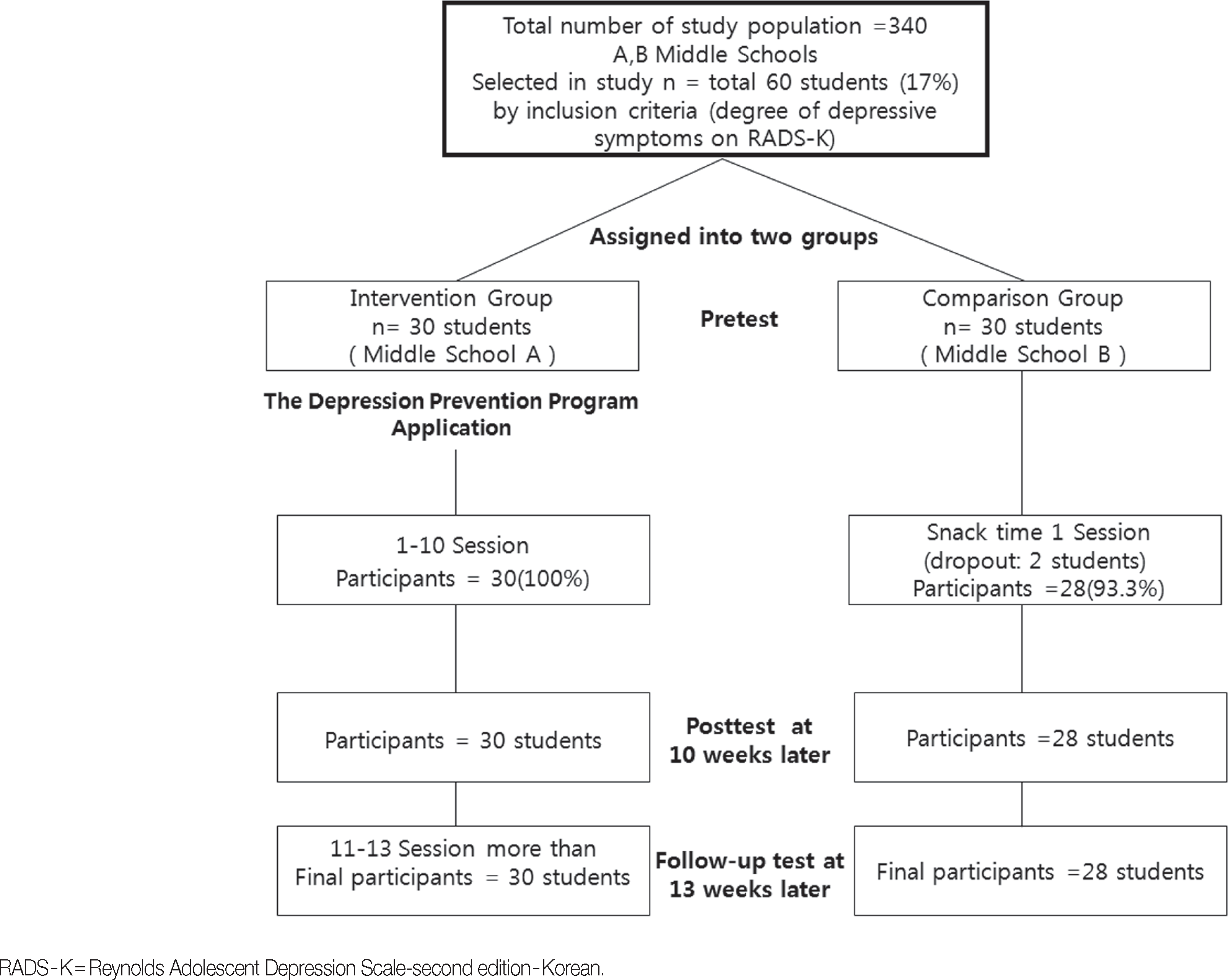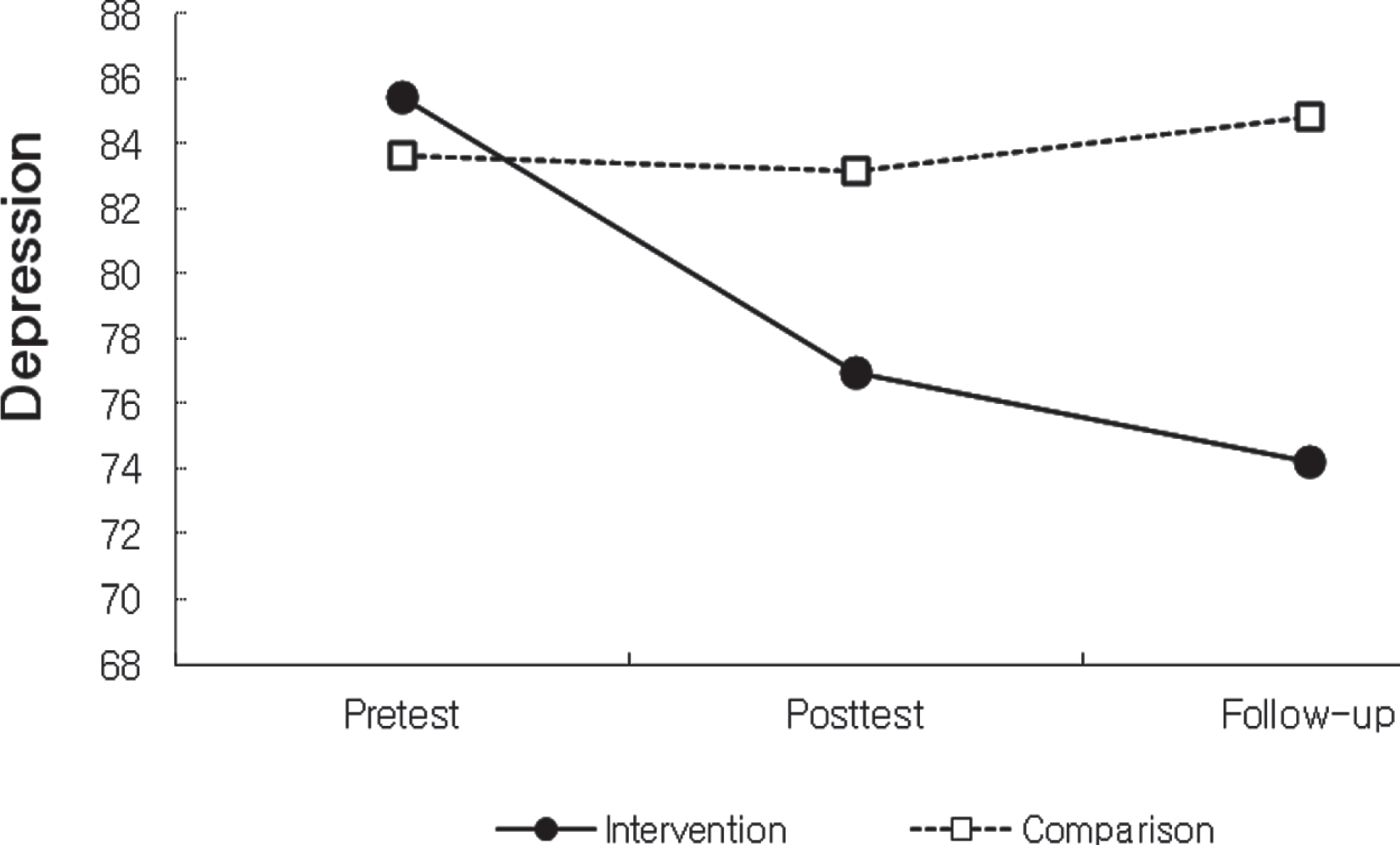Abstract
Purpose
The purpose of this study was to evaluate the effects of a school-based intervention program for middle school adolescent girls with depression.
Methods
The study was a pretest–posttest repeated-measure design with a nonequivalent control group. Fifty eight students with depressive symptoms were recruited from two middle schools in Seoul, Korea. The data were collected from the intervention (n= 30) and the comparison group (n= 28). The research instrument was Reynolds Adolescent Depression Scale.
Results
The intervention group greatly improved from baseline to 10 weeks and then saw a slight positive change between 10 and 13 weeks.
Conclusion
The results of this research show that depression intervention programs are effective for young female adolescents. Thus the investigation has important school-based treatment implications, and should be integrated into school curriculums by school health nurses for early intervention of depressive symptoms in middle school adolescent girls.
Go to : 
References
Balaji M.., Andrews T.., Andrew G.., Patel, V. 2011. The acceptability, feasibility, and effectiveness of a population-based intervention to promote youth health: An exploratory study in Goa, India. Journal of Adolescent Health. 48(5):453–460. http://dx.doi.org/10.1016/j.jadohealth.2010.07.029.

Birndorf S.., Ryan S.., Auinger P.., Aten, M. 2005. High self-esteem among adolescents: Longitudinal trends, sex differences, and protective factors. Journal of Adolescent Health. 37(3):194–201. http://dx.doi.org/10.1016/j.jadohealth.2004.08.012.

Cole D. A.., Jacquez F. M.., Truss A. E.., Pineda A. Q.., Weitlauf A. S.., Tilghman -Osborne C. E., et al2009. Gender differences in the longitudinal structure of cognitive diatheses for depression in children and adolescents. Journal of Clinical Psychology. 65(12):1312–1326. http://dx.doi.org/10.1002/jclp.20631.

Costello E. J.., Mustillo S.., Keeler G.., Angold, A. 2004. Children and adolescents. Levin B.L., Petrila J., Hennessy K., editorsMental Health Services: A public health perspective. New York: Oxford University Press.
Collins K. A.., Westra H. A.., Dozois D. J. A.., Burns D.D. 2004. Gaps in accessing treatment for anxiety and depression: Challenges for the delivery of care. Clinical Psychology Review. 24(5):583–616. http://dx.doi.org/10.1016/j.cpr.2004.06.001.

Daughters S. B.., Reynolds E. K.., MacPherson L.., Kahler C. W.., Danielson C. K.., Zvolensky M., et al2009. Distress tolerance and early adolescent externalizing and internalizing symptoms: The moderating role of gender and ethnicity. Behaviour Research and Therapy. 47(3):198–205. http://dx.doi.org/10.1016/j.brat.2008.12.001.

Faul F.., Erdfelder E.., Lang A. G.., Buchner, A. 2007. G*Power 3: A flexible statistical power analysis program for the social, behavioral, and biomedical sciences. Behavior Research Methods. 39(2):175–191. http://dx.doi.org/10.3758/BF03193146.

Fergusson D. M.., Horwood L. J.., Ridder E. M.., Beautrais A.L. 2005. Subthreshold depression in adolescence and mental health outcomes in adulthood. Archives of General Psychiatry. 62(1):66–72. http://dx.doi.org/10.1001/archpsyc.62.1.66.

Frydenberg, E. 2008. Adolescent Coping: Advances in theory, research and practice. Routledge;New York:
Health P. A.., Camarena P.M. 2002. Patterns of depressed affect during early adolescence. Journal of Early Adolescence. 22(3):252–276. http://dx.doi.org/10.1177/02731602022003002.
Hess S. G.., Cox T. S.., Gonzales L. C.., Kastelic E. A.., Mink S. P.., Rose L. E., et al2004. A survey of adolescents’ knowledge about depression. Archives of Psychiatric Nursing. 18(6):228–234. http://dx.doi.org/10.1016/j.apnu.2004.09.005.

Jaycox L. H.., Asarnow J. R.., Sherbourne C. D.., Rea M. M.., LaBorde A. P.., Wells K.B. 2006. Adolescent primary care patients’ preferences for depression treatment. Administration and Policy in Mental Health and Mental Health Services Research. 33(2):198–207. http://dx.doi.org/10.1007/s10488-006-0033-7.

Kowalenko N.., Rapee R. M.., Simmons J.., Wignall A.., Hoge R.., Whitefield K., et al2005. Short-term effectiveness of a school-based early intervention program for adolescent depression. Clinical Child Psychology and Psychiatry. 10(4):493–507. http://dx.doi.org/10.1177/1359104505056311.
Merry S.., McDowell H.., Wild C. J.., Bir J.., Cunliffe, R. 2004. A randomized placebo-controlled trial of a school-based depression prevention program. Journal of American Academy Child and Adolescent Psychiatry. 43(5):538–547. http://dx.doi.org/10.1097/00004583-200405000-00007.

Reynolds, W. 2002. Reynolds Adolescent Depression Scale: Professional manual. 2nd ed.Odessa, FL: Psychological Assessment Resources, Inc., Odessa, FL.
Robins R. W.., Trzesniewski K.H. 2005. Self-esteem development across the lifespan. American Psychological Society. 14(3):158–162.

Rohde P.., Beevers C. G.., Stice E.., O'Neil, K. 2009. Major and minor depression in female adolescents: Onset, course, symptom presentation, and demographic associations. Journal of Clinical Psychology. 65(12):1339–1349. http://dx.doi.org/10.1002/jclp.20629.

Sawyer M. G.., Harchak T. F.., Spence S. H.., Bond L.., Graetz B.., Kay D., et al2010. School based prevention of depression: A 2-year follow-up of a randomized controlled trial of the beyondblue schools research initiative. Journal of Adolescent Health. 47(3):297–304. http://dx.doi.org/10.1016/j.jadohealth.2010.02.007.
Schultz J. L.., Mueller, D. 2007. Effective interventions for the prevention and treatment of depression and adolescent girls: A review of relevant research. Saint Paul, MN: Wilder Research.
Statistics Korea. 2011a. 2008 Adolescent health report. Retrieved December 20, 2011, from. http://stat.mw.go.kr/stat/data/cm_data_view.jsp?menu_code=MN02010000&cont_seq=10322.
Statistics Korea. 2011b. 2009 Mortality data base. Retrieved December 20, 2011, from. http://kostat.go.kr/portal/korea/kor_nw/2/6/2/index.board?bmode=read&aSeq=179505.
Swartz K. L.., Kastelic E. A.., Hess S. G.., Cox T. S.., Gonzales L. C.., Mink S. P., et al2007. The effectiveness of a school-based adolescent depression education program. Health Education Behavior. 37:11–22. http://dx.doi.org/10.1177/1090198107303313.

Tandon D. S.., Solomon B.S. 2009. Risk and protective factors for depressive symptoms in urban African American adolescents. Youth & Society. 41(1):80–99. http://dx.doi.org/10.1177/0044118X08327520.

Go to : 
Table 1.
The Contents of School-based Intervention Program for a Middle School Girls with Depression
Table 2.
Homogeneity Test for Demographic Characteristics of the Participants (N=58)
Table 3.
Comparison of Depressive Symptoms between Intervention and Comparison Groups (N=58)




 PDF
PDF ePub
ePub Citation
Citation Print
Print




 XML Download
XML Download